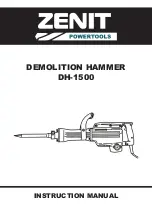
5
ENGLISH
adjustments, changing accessories, or storing power
tools.
Such preventive safety measures reduce the risk of
starting the power tool accidentally.
d. Store idle power tools out of the reach of children and
do not allow persons unfamiliar with the power tool or
these instructions to operate the power tool.
Power
tools are dangerous in the hands of untrained users.
e. Maintain power tools and accessories. Check for
misalignment or binding of moving parts, breakage of
parts and any other condition that may affect the
power tools operation. If damaged, have the power
tool repaired before use.
Many accidents are caused by
poorly maintained power tools.
f. Keep cutting tools sharp and clean.
Properly
maintained cutting tools with sharp cutting edges are less
likely to bind and are easier to control.
g. Use the power tool, accessories and tool bits etc. in
accordance with these instructions, taking into
account the working conditions and the work to be
performed.
Use of the power tool for operations different
from those intended could result in a hazardous situation.
h. Keep handles and grasping surfaces dry, clean and
free from oil and grease.
Slippery handles and greasy
surfaces do not allow for safe handling and control of the
tool in unexpected situations.
5. Service
a. Have your power tool serviced by a qualified repair
person using only identical replacement parts.
This will
ensure that the safety of the power tool is maintained.
Additional power tool safety warnings
@
Warning!
Additional safety warnings for
rotary and chiselling hammers
u
Wear ear protectors.
Exposure to noise can cause
hearing loss
.
u
Use auxiliary handles supplied with the tool.
Loss of
control can cause personal injury.
u
Hold power tool by insulated gripping surfaces when
performing an operation where the cutting accessory
may contact hidden wiring.
Cutting accessory contacting
a "live" wire may make exposed metal parts of the power
tool "live" and could give the operator an electric shock.
u
Never use a chisel accessory in rotary mode.
The
accessory will bind in the material and rotate the drill.
u
Use clamps or another practical way to secure and
support the workpiece to a stable platform.
Holding the
work by hand or against your body leaves it unstable and
may lead to loss of control.
u
Before drilling into walls, floors or ceilings, check for the
location of wiring and pipes.
u
Avoid touching the tip of a drill bit just after drilling, as it
may be hot.
u
The intended use is described in this instruction manual.
The use of any accessory or attachment or performance
of any operation with this tool other than those
recommended in this instruction manual may present
a risk of personal injury and/or damage to property.
Safety of others
u
This tool can be used by children aged from 8 years and
above and persons with reduced physical, sensory or
mental capabilities or lack of experience and knowledge
if they have been given supervision or instruction
concerning use of the tool in a safe way and understand
the hazards involved.
u
Children shall not play with the tool. Cleaning and user
maintenance shall not be made by children without
supervision.
Residual risks
Additional residual risks may arise when using the tool which
may not be included in the enclosed safety warnings. These
risks can arise from misuse, prolonged use etc.
Even with the application of the relevant safety regulations
and the implementation of safety devices, certain residual
risks can not be avoided. These include:
u
Injuries caused by touching any rotating/moving parts.
u
Injuries caused when changing any parts, blades or
accessories.
u
Injuries caused by prolonged use of a tool. When using
any tool for prolonged periods ensure you take regular
breaks.
u
Impairment of hearing.
u
Health hazards caused by breathing dust developed when
using your tool (example:- working with wood, especially
oak, beech and MDF.)
Vibration
The declared vibration emission values stated in the technical
data and the declaration of conformity have been measured
in accordance with a standard test method provided by EN
60745 and may be used for comparing one tool with another.
The declared vibration emission value may also be used in
a preliminary assessment of exposure.
Warning!
The vibration emission value during actual use of
the power tool can differ from the declared value depending
on the ways in which the tool is used. The vibration level may
increase above the level stated.
When assessing vibration exposure to determine safety
measures required by 2002/44/EC to protect persons regularly
using power tools in employment, an estimation of vibration


































